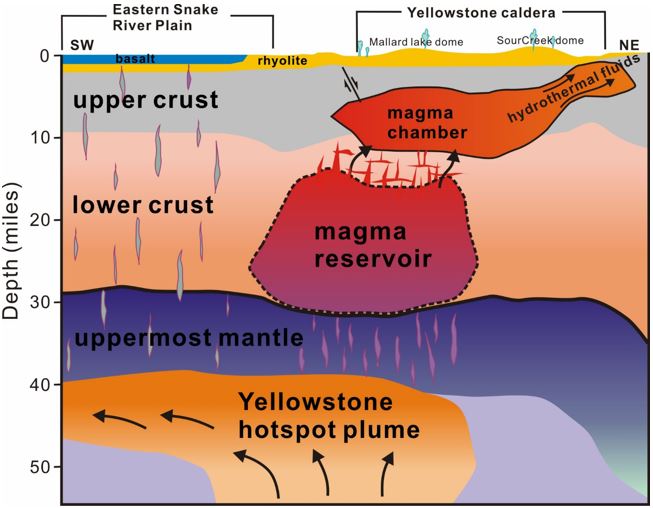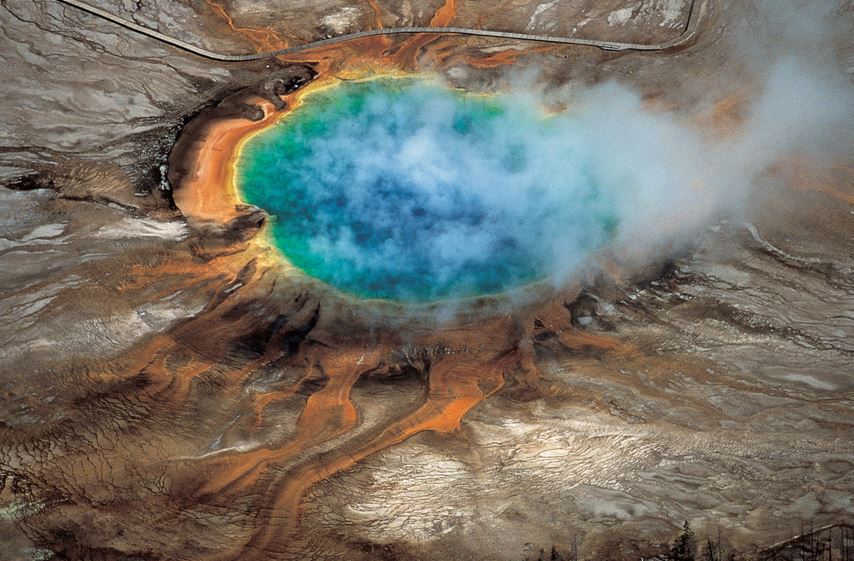A magma chamber 12 to 28 miles beneath the Yellowstone supervolcano shows it is 4.4 times more massive and vastly deeper than the one volcanologists have known about above it, says a team of seismologists from the University of Utah, the California Institute of Technology and the University of New Mexico.
The newly-discovered magma chamber has enough molten material to fill the whole of the Grand Canyon 11.2 times, compared to 2.5 times that the previously-known magma chamber would manage, says postdoctoral researcher Jamie Farrel.
The research team wrote about their findings in the academic journal Science (citation below).
Even though it is a mega-monster supervolcano, the scientists insist their discovery is no reason to be scared. The chances that it will erupt are about 1 in 700,000 each year, they say.

A cross-section illustration cutting southwest-northeast under Yelowstone depicts the view revealed by seismic imaging. (Credit: Hsin-Hua. Image: utah.edu)
Post-doctoral researcher in geology and geophysics and also first author, Hsin-Hua Huang, said:
“For the first time, we have imaged the continuous volcanic plumbing system under Yellowstone.”
“That includes the upper crustal magma chamber we have seen previously plus a lower crustal magma reservoir that has never been imaged before and that connects the upper chamber to the Yellowstone hotspot plume below.”
The magma chamber and magma reservoir do not consists of molten rock, as most people believe. It is full of hot, mostly solid and spongelike rock, with pockets of molten rock within it.
According to Huang, the upper magma chamber averages approximately 9% molten rock, which is within earlier estimates of between 5% and 15% melt, while the lower magma reservoir is about 2% melt.
Farrel says there is the equivalent of about one-quarter of a Grand Canyon’s worth of molten rock within the much bigger volumes of either the magma chamber or the magma reservoir.
Does not mean Yellowstone is more dangerous
The scientists insist that Yellowstone’s plumbing system is no bigger – nor nearer to erupting – than before the study.
The new findings are thanks to the advanced techniques they used to make a complete image of the system that carries hot and partly molten rock from the top of the supervolcano’s hotspot plume – about 40 miles below the surface – to the magma reservoir and the magma chamber above it.
Farrell said:
“The magma chamber and reservoir are not getting any bigger than they have been, it’s just that we can see them better now using new techniques.”
Assistant professor of geology and geophysics, co-author Fan-Chi Lin, said:
“It gives us a better understanding the Yellowstone magmatic system. We can now use these new models to better estimate the potential seismic and volcanic hazards.”
The discovery of the underlying magma reservoir that supplies the magma chamber does not change the source of three cataclysmic eruptions of the Yellowstone caldera 640,000, 1.2 million and 2 million years ago – the source was the previously known upper magma chamber.

The magnificent colors of Yellowstone National Park’s Grand Prismatic hot spring are among the park’s myriad hydrothermal features created by the fact that Yellowstone is a supervolcano – the largest type of volcano on Earth. (Photo Credit: “Windows into the Earth,” Robert B. Smith and Lee J. Siegel. Image: utah.edu)
The actual hazard remains unchanged
Co-author Robert B. Smith, a research and emeritus professor of geology and geophysics, said:
“The actual hazard is the same, but now we have a much better understanding of the complete crustal magma system.”
The three eruptions of the Yellowstone supervolcano – on the Wyoming-Idaho-Montana border – covered most of the North American continent in volcanic ash.
If an eruption occurred today it would be ‘cataclysmic’, Smith said, but added that the chances of one happening are extremely remote.

University of Utah seismologists (from left to right) Fan Chi-Lin, Hsin-Hua Huang, Robert B. Smith and Jamie Farrell. (Credit: Lee J. Siegel. Image: utah.edu)
Before this new discovery, experts had believed that partly molten rock moved upward from the Yellowstone hotspot plume through a series of vertical and horizontal cracks, known as dikes and sills, or as blobs.
They still think that such cracks move hot rock from the plume head to the magma reservoir, and to the shallow magma chamber from there.
Citation: “The Yellowstone magmatic system from the mantle plume to the upper crust,” Hsin-Hua Huang, Fan-Chi Lin, Brandon Schmandt, Jamie Farrell, Robert B. Smith, and Victor C. Tsai. Science. Published online 23 April 2015. DOI:10.1126/science.aaa5648.
Video – NSF Yellowstone Discovery
This National Science Foundation video summarizes a study led by seismologists at the University of Utah on the Yellowstone supervolcano.
